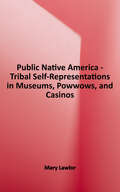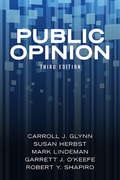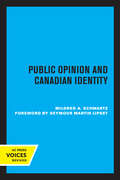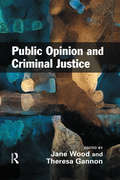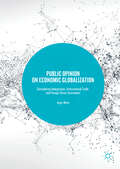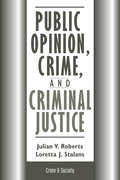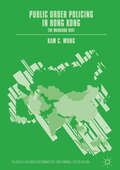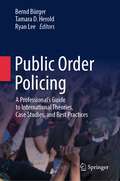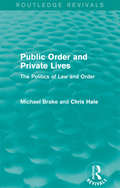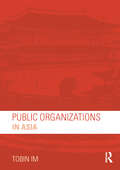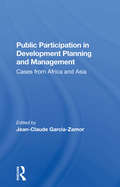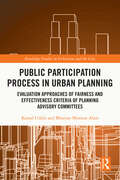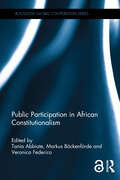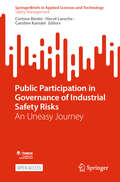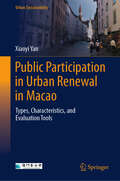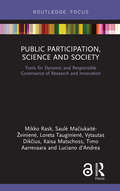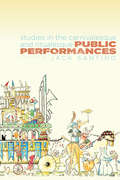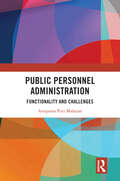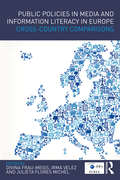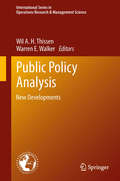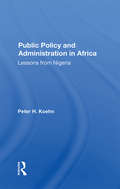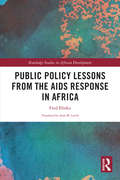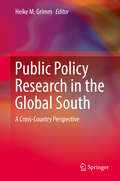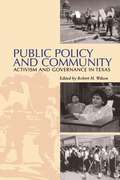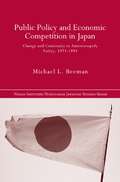- Table View
- List View
Public Native America: Tribal Self-Representations in Museums, Powwows, and Casinos
by Mary LawlorThe Native American casino and gaming industry has attracted unprecedented American public attention to life on reservations. Other tribal public venues, such as museums and powwows, have also gained in popularity among non-Native audiences and become sites of education and performance. In Public Native America, Mary Lawlor explores the process of tribal self-definition that the communities in her study make available to off-reservation audiences. Focusing on architectural and interior designs as well as performance styles, she reveals how a complex and often surprising cultural dynamic is created when Native Americans create lavish displays for the public’s participation and consumption. Drawing on postcolonial and cultural studies, Lawlor argues that these venues serve as a stage where indigenous communities play out delicate negotiations―on the one hand retaining traditional beliefs and rituals, while on the other, using what they have learned about U.S. politics, corporate culture, tourism, and public relations to advance their economic positions.
Public Opinion
by Susan Herbst Carroll J. Glynn Robert Y. Shapiro Mark Lindeman Garrett J. O'KeefePublic Opinion is a comprehensive and multidisciplinary examination of public opinion in the United States. Drawing on scholarship in political science, psychology, sociology, and communications, the authors explore the nature of political and social attitudes in the United States and how these attitudes are shaped by various institutions, with an emphasis on mass media. The book also serves as a provocative starting point for the discussion of citizen moods, political participation, and voting behavior. Feature boxes and illustrations throughout help students understand all aspects of the elusive phenomenon we call public opinion. The third edition has been thoroughly revised and updated to reflect how public opinion is studied today, and to incorporate current data and debates. The book now contains two revised and reframed theory chapters--"Group Membership and Public Opinion” and "Public Opinion and Social Process”--as well as new coverage of the influence of online and social media on public opinion, especially in issue opinions and campaigns.
Public Opinion and Canadian Identity
by Mildred A. SchwartzThis title is part of UC Press's Voices Revived program, which commemorates University of California Press’s mission to seek out and cultivate the brightest minds and give them voice, reach, and impact. Drawing on a backlist dating to 1893, Voices Revived makes high-quality, peer-reviewed scholarship accessible once again using print-on-demand technology. This title was originally published in 1967.
Public Opinion and Criminal Justice: Context, Practice and Values
by Jane Wood Theresa A. GannonPublic opinion is vital to the functioning of the criminal justice system but it is not at all clear how best to establish what this is, and what views people have on different aspects of criminal justice and the criminal justice system. Politicians and the media often assume that the public wants harsher, tougher and longer sentences, and policies may be shaped accordingly. Detailed research and more specific polling often tells a different story. This book is concerned to shed further light on the nature of public views on criminal justice, paying particular attention to public opinion towards specific types of offenders, such as sex offenders and mentally disordered offenders. In doing so it challenges many enduring assumptions regarding people's views on justice, and confronts the myths that infect our understanding of what people think about the criminal justice system.
Public Opinion on Economic Globalization
by Roger WhiteThis book examines survey data to consider the extent to which public support for immigration, international trade, and foreign direct investment exists in a cohort of 38 heterogeneous countries. With economic globalization shaping daily life, understanding the determinants of public opinion is crucial for policy makers. This timely volume uses survey data from the Pew Research Center's 2006-2014 Global Attitudes Project (GAP) in conjunction with data from several secondary sources. White identifies the factors that underlie the reluctance of some members of the public, and some societies, to view these topics in a more positive light. Specifically, he considers the roles of culture, cultural differences ("cultural distance"), and relative social and economic development as determinants of public opinion and corresponding cross-societal differences of opinion.
Public Opinion, Crime, and Criminal Justice: Public Opinion In England And Wales (Crime and Society)
by Julian RobertsTaking on one of the most popular issues of the day—crime and the way we make sense of it—Julian Roberts and Loretta Stalans reveal the mismatch between the public perception of crime and the reality of crime statistics. Discussing such issues as public knowledge of crime, sources of crime information, information processing by the public, public attitudes about crime, and the effectiveness of punishment, this book considers the role that public opinion plays in the politics of criminal justice issues. Based on extensive data from the United States, with comparisons with Canada and the United Kingdom, Roberts and Stalans reveal the truth behind how the public perceives crime and how this perception compares to actual criminal activity.
Public Order Policing in Hong Kong: The Mongkok Riot (Palgrave Advances in Criminology and Criminal Justice in Asia)
by Kam C. WongThis book examines the Hong Kong Mongkok Riot (MKR) of 2016 to offer a clear and objective account of the events as they unfolded, to dispel the myths, and to explore what can be learned from it. It draws on multiple sources including: public survey data, eyewitness accounts, LegCo proceedings, official press releases, newspaper reports, and video presentations. The study investigates the causes, issues and impacts of MKR including how the media reported it. It examines the historical context surrounding MKR, before and after, and considers the importance of this independent inquiry including its use and limitations. It aims to bring closure to the event, establish a record for the future, provide insightful data for cross-cultural studies on riots, and offer insights for police scholars, security consultants, political scientists, Asian and Chinese studies scholars, and comparative criminal justice researchers.
Public Order Policing: A Professional's Guide to International Theories, Case Studies, and Best Practices
by Ryan Lee Bernd Bürger Tamara D. HeroldSuccessful public order management is critical to upholding democracy and maintaining the rule of law. Negative police-public interactions during assemblies can impact the safety and well-being of citizens and officers, as well as local and international perceptions of police legitimacy. As observed during events across the world, including assemblies in the U.S., Myanmar, Belarus, Russia, and elsewhere, police mismanagement of mass demonstrations often instigates crowd violence and other harmful behaviors. The causes of violence at assemblies are complex and multi-faceted. Failure to understand crowd dynamics that lead to violence limits police effectiveness and contributes to poor officer decision-making. This book offers an international review of public order management experiences and effective practices. Practical examples, grounded in multi-disciplinary theory and science, offer a roadmap to improve police response and increase safety at assemblies in democratic countries. The diverse content, perspectives, and lessons learned presented in this volume will serve as a useful guide for all people working in the field of public order management, including police officials, policymakers, and researchers. This edited volume was written by and for practitioners, pracademics, and academics to review the complex and demanding task of policing public order.
Public Order and Private Lives: The Politics of Law and Order (Routledge Revivals)
by Chris Hale Michael BrakeFirst published in 1992, Public Order and Private Lives is a radical examination of the political forces which shaped the law and order debate in Britain at that time. The authors offer a significant and provoking analysis of Conservative policies on crime, showing that, ironically, they created the very social conditions in which crime flourished. The book argues that the Conservative government undermined basic civil liberties by its increased use of legislation as a means of control and coercion, and as a result of this, crime increased under their governance.
Public Organizations in Asia
by Tobin ImPublic Organizations in Asia introduces students to the fundamental theories of organizations and teaches them how to analyze different types of public organizations in East and Southeast Asia. Moving away from traditional Western theory and examples, this textbook provides numerous case studies of Asian organizations where different ideologies, administrative tradition, and social circumstances prevail. Key pedagogical features of Public Organizations in Asia include: Learning objectives for each chapter End of chapter discussion questions Short student exercises Concise case studies throughout the chapters Training students to be future leaders of Asian public organizations, this book is an essential text for undergraduate and graduate courses on public administration in Asia. It will also be a useful supplementary text for courses on comparative public administration.
Public Participation In Development Planning And Management: Cases From Africa And Asia
by Jean-claude Garcia-zamorThis book examines the position held by most development administrators that citizen participation in the planning and management of development projects is crucial to their lasting success. The contributors view inadequate participation as part of the larger problem of ineffective management, policies, and planning. They show that development obje
Public Participation Process in Urban Planning: Evaluation Approaches of Fairness and Effectiveness Criteria of Planning Advisory Committees (Routledge Studies in Urbanism and the City)
by Kamal Uddin Bhuiyan Monwar AlamThis book critically examines the public participation processes in urban planning and development by evaluating the operations of Planning Advisory Committees (PACs) through two meta-criteria of fairness and effectiveness. Traditional models of public participation in planning have long been criticized for separating planners from the public. This book proposes a novel conceptual model to address the gaps in existing practices in order to encourage greater public involvement in planning decisions and policymaking. It assesses the application of the evaluative framework for PACs as a new approach to public participation evaluation in urban planning. With a case study focused on the PACs in Inner City area of Canberra, Australia, the book offers a conceptual framework for evaluating fairness and effectiveness of the public participation processes that can also be extended to other countries such as the United States, the United Kingdom, New Zealand, Canada, Scandinavian countries, the European Union, and some Asian countries such as India. Offering valuable insights on how operational processes of PACs can be re-configured, this book will be a useful guide for students and academics of planning and public policy analysis, as well as the planning professionals in both developed and developing countries.
Public Participation in African Constitutionalism (Routledge Global Cooperation Series)
by Tania Abbiate, Markus Böckenförde and Veronica FedericoDuring the last decade of the 20th century, Africa has been marked by a "constitutional wind" which has blown across the continent giving impetus to constitutional reforms designed to introduce constitutionalism and good governance. One of the main features of these processes has been the promotion of public participation, encouraged by both civil society and the international community.This book aims to provide a systematic overview of participation forms and mechanisms across Africa, and a critical understanding of the impact of public participation in constitution-making processes, digging beneath the rhetoric of public participation as being at the heart of any successful transition towards democracy and constitutionalism. Using case studies from Central African Republic, Egypt, Kenya, Libya, Malawi, Morocco, Senegal, Somalia, South Africa, South Sudan, Tanzania, Tunisia, Zambia and Zimbabwe, the book investigates various aspects of participatory constitution making: from conception, to processes, and specific contents that trigger ambivalent dynamics in such processes. The abstract glorification of public participation is questioned as theoretical and empirical perspectives are used to explain what public participation does in concrete terms and to identify what lessons might be drawn from those experiences.This is a valuable resource for academics, researchers and students with an interest in politics and constitution building in Africa, as well as experts working in national offices, international organizations or in national and international NGOs.
Public Participation in Governance of Industrial Safety Risks: An Uneasy Journey (SpringerBriefs in Applied Sciences and Technology)
by Corinne Bieder Hervé Laroche Caroline KamatéThis open access book contributes to the increasing trend toward greater public participation in decision-making in many areas of public life, particularly in the field of the environment and sustainable development. It describes the outcome of a two-day workshop, organized by the Foundation for an Industrial Safety Culture in 2023, that addresses the continuing sensitivities surround the impact of hazardous industrial activities. Public Participation in Governance of Industrial Safety Risks brings together international academic experts as well as industrial and institutional representatives to shed light on the topics discussed during this workshop. Through the viewpoints of experts from various disciplines, industrial sectors, and countries, it offers an opportunity to gain a better grasp of the multiplicity and complexity of participatory processes and to understand their expected benefits, their drawbacks, and potential pitfalls. The work supports the making of better-informed decisions, especially by industrial or regulatory actors, to engage or not with public participation.
Public Participation in Urban Renewal in Macao: Types, Characteristics, and Evaluation Tools (Urban Sustainability)
by Xiaoyi YanThis book analyses of public participation in the different development stages of urban renewal in Macao. Three types of participation are summarized from practice, analyzed their characteristics. And then develops a framework and a set of standards of participation quality evaluation that are applicable to Macao. Through a case study of public consultation meeting on Macao Urban Renewal Legal System, the participation quality of government-led public participation was evaluated. Finally, the applicability of the evaluation framework and standards was discussed. This book enriches the existing theories, and it provides new experience and the cases of public participation in urban renewal. Public participation in a new local context with multicultural and strong social connections was discussed. It builds the systems theoretical foundation on this field in Macao. It is a useful book for graduate students and the researcher in the academic field of urban renewal or urban governance to understand the public participation in urban renewal theory. This book can provide references for the government, associations, and private individuals to initiate and carry out public participation activities. It could provide decision-makers and researchers in Macao a reference for the quality evaluation of public participation.
Public Participation, Science and Society: Tools for Dynamic and Responsible Governance of Research and Innovation
by Timo Aarrevaara Mikko Rask Saulė Mačiukaitė-Žvinienė Loreta Tauginienė Vytautas Dikčius Kaisa Matschoss Luciano d’AndreaThe field of public participation is developing fast, with phenomena such as citizen science and crowdsourcing extending the resource base of research, stimulating innovation and making science more accessible to the general population. Promoting public participation means giving more weight to citizens and civil society actors in the definition of research needs and in the implementation of research and innovation. As yet, there is limited understanding of the implications of widespread use of public participation and as a result, there is a risk that it will become a burden for research and an obstacle to bridging the gap between research and society. This volume presents the findings of a three-year international study on innovative public participation. The resulting work studies the characteristics and trends of innovative public participation through a global sample of 38 case studies. It provides theoretical generalisations on the dynamics of public participation, suggestions for an evaluation framework and clear empirical examples of how public participation works in practice. Illustrated by best practice cases, the authors identify characteristics which contribute to successful public participation. The book is aimed primarily at scholars and practitioners of public participation, as well as research managers, policy makers and business actors interested in related issues. There is also a secondary market for students and scholars of European governance studies, sociology and political sciences.
Public Performances: Studies in the Carnivalesque and Ritualesque (Ritual, Festival, and Celebration)
by Jack SantinoPublic Performances offers a deep and wide-ranging exploration of relationships among genres of public performance and of the underlying political motivations they share. Illustrating the connections among three themes—the political, the carnivalesque, and the ritualesque—this volume provides rich and comprehensive insight into public performance as an assertion of political power. Contributors consider how public genres of performance express not only celebration but also dissent, grief, and remembrance; examine the permeability of the boundaries between genres; and analyze the approval or regulation of such events by municipalities and other institutions. Where the particular use of public space is not sanctioned or where that use meets with hostility from institutions or represents a critique of them, performers are effectively reclaiming public space to make public statements on their own terms—an act of popular sovereignty. Through these concepts, Public Performances distinguishes the sometimes overlapping dimensions of public symbolic display. Carnival, and thus the carnivalesque, is understood to possess tacit social permission for unconventional or even deviant performance, on the grounds that normal social order will resume when the performance concludes. Ritual, and the ritualesque, leverages a deeper symbolic sensibility, one believed—or at least intended—by the participants to effect transformative, longer-term change. Contributors: Roger D. Abrahams, John Borgonovo, Laurent Sébastien Fournier, Lisa Gilman, Barbara Graham, David Harnish, Samuel Kinser, Scott Magelssen, Elena Martinez, Pamela Moro, Beverly J. Stoeltje, Daniel Wojcik, Dorothy L. Zinn
Public Personnel Administration: Functionality and Challenges
by Anupama Puri MahajanThis book addresses the processes and concerns within the purview of public personnel administration which is the key to success in carrying out governmental responsibilities and duties. With special focus on Indian administrative system, this volume probes into how public personnel administration is a critical aspect of the public sector that involves enhanced management of human resources. It also studies the evolution of public personnel administration in countries like the USA, UK, France, and Germany. Besides discussing the personnel processes in the post pandemic age, the book also examines the challenges that governments face on a global level. This title will be useful to students, researchers and teachers of Public Administration, Public Policy, Political Science, and General Management. The book will also be an invaluable companion to the policymakers in the government sector as it will strengthen their conceptual understanding of the subject.
Public Policies in Media and Information Literacy in Europe: Cross-Country Comparisons
by Divina Frau-Meigs Irma Velez Julieta Flores MichelPublic Policies in Media and Information Literacy in Europe explores the current tensions in European countries as they attempt to tackle the transition to the digital age, providing a comparative and cross-cultural analysis of Media and Information Literacy (MIL) across Europe. This book takes a long-term perspective over the development of media education in Europe, and includes an appraisal of media, information, computer and digital literacies as they coalesce and diverge in the public debate over twenty-first-century skills. The contributors assess the various definitions of media and information literacy as a composite notion whose evolution as a cross-cultural phenomenon reveals various trends and influences in Europe. Throughout, this volume offers an in-depth coverage of MIL with all the different dimensions of policy-making, from legal frameworks to training, funding, evaluation and good practices. The authors propose modeling current MIL governance trends in Europe and conclude with a call for alternative and collective frames of research that they hope will influence policy-makers and other stakeholders, especially in terms of MIL governance. This collection is ideal for students and researchers of MIL, as well as policy makers, educators and associations interested in MIL in the digital age.
Public Policy Analysis
by Warren E. Walker Wil A. ThissenTraditional policy analysis approaches are characterized by a focus on system modeling and choosing among policy alternatives. While successful in many cases, this approach has been increasingly criticized for being technocratic and ignoring the behavioral and political dimensions of most policy processes. In recent decades, increased awareness of the multi-actor, multiple perspective, and poly-centric character of many policy processes has led to the development of a variety of different perspectives on the styles and roles of policy analysis, and to new analytical tools and approaches - for example, argumentative approaches, participative policy analysis, and negotiation support. As a result, the field has become multi-faceted and somewhat fragmented. Public Policy Analysis: New Developments acknowledges the variety of approaches and provides a synthesis of the traditional and new approaches to policy analysis. It provides an overview and typology of different types of policy analytic activities, characterizing them according to differences in character and leading values, and linking them to a variety of theoretical notions on policymaking. Thereby, it provides assistance to both end users and analysts in choosing an appropriate approach given a specific policy situation. By broadening the traditional approach and methods to include the analysis of actors and actor networks related to the policy issue at hand, it deepens the state of the art in certain areas. While the main focus of the book is on the cognitive dimensions of policy analysis, it also links the policy analysis process to the policymaking process, showing how to identify and involve all relevant stakeholders in the process, and how to create favorable conditions for use of the results of policy analytic efforts by the policy actors. The book has as its major objective to describe the state-of-the-art and the latest developments in ex-ante policy analysis. It is divided into two parts. Part I explores and structures policy analysis developments, the development and description of approaches to diagnose policy situations, design policy analytic efforts, and policy process conditions. Part II focuses on recent developments regarding models and modeling for policy analysis, placing modeling approaches in the context of the variety of conditions and approaches elaborated in Part I.
Public Policy And Administration In Africa: Lessons From Nigeria
by Peter KoehnOriginally published in 1990. A look at the vast, historically and socially complex nature of the Nigeria This book is intended to share what he has learned about public policy and administration in Africa over the past ten years. This book is based upon a decade of research, reflection, and writing. The field research period corresponds with the
Public Policy Lessons from the AIDS Response in Africa (Routledge Studies in African Development)
by Fred EbokoPublic Policy Lessons from the AIDS Response in Africa examines how the interplay between national state dynamics in Africa and the global political arena has shaped the global AIDS response, and in this context develops a framework for analysing public policy action more broadly in contemporary Africa. By applying comparative political sociology to AIDS public action, this book identifies four political models that are applicable to public initiatives. Fred Eboko goes on to test these in other domains – namely, the malaria and tuberculosis health subsectors, and the education and environment sectors. By articulating global and national connections and contributing a critical perspective grounded in African scholarship and French political science, the author builds a bold and ambitious framework with the potential to enable coherent and effective public policy action in Africa. This book will be of interest to scholars and students of public health, global health, political science, and development studies, as well as policy-level practitioners in the areas of global health and development.
Public Policy Research in the Global South: A Cross-Country Perspective
by Heike M. GrimmThis volume focuses on the evolution of public policy and the role of agenda setting with regard to policymaking in countries of the Global South. The authors illustrate the emergence of public policy research as an academic discipline, and highlight various aspects of history, governance, politics, and economics as components of public policy theory development. By offering a cross-national perspective, the papers contribute to a better understanding of when, how, and by whom a given policy agenda is designed, which is essential to grasping how policy is implemented. In turn, the authors investigate how the development of public policy research has influenced policymaking in fields such as democratization, migration, corruption, agriculture, environment, education, and entrepreneurship and, more specifically, agenda setting in selected countries of the Global South.
Public Policy and Community: Activism and Governance in Texas
by Robert H. WilsonThe decentralization of public policy from the federal government to state and local governments offers increased opportunities for ordinary citizens to participate directly in public policymaking. <P><P>Yet these opportunities may not be equally shared. Due to a variety of factors, low-income citizens have long been denied a meaningful role in the public life and governance of our country. <P> By contrast, the essays in this volume explore how low-income citizens have successfully affected public policy. The book is built around six case studies, all from Texas, that cover education finance and reform, local infrastructure provision, environmental protection, and indigent health care.
Public Policy and Economic Competition in Japan: Change and Continuity in Antimonopoly Policy, 1973-1995 (Nissan Institute/Routledge Japanese Studies)
by Michael L. BeemanViewed historically as the lapdog of business, bureaucratic and political interests, Japan's Fair Trade Commission has had mixed success in promoting its agenda for stronger antimonopoly policy since the early 1970s. Dr. Beeman unravels antimonopoly politics in Japan through an analysis of the diverse interests of industry, government, and other parties to reveal how and why antimonopoly policy has made important inroads yet ultimately failed to gain deep acceptance in Japan.Employing extensive use of primary research materials and numerous interviews, Dr. Beeman finds predictable patterns of change as well as themes of continuity in the development of Japan's antimonopoly policy. By addressing a broad array of industry sectors and policy issues, the book provides fresh insight into an agency and a policy that have often been criticized from within Japan as too stringent and from outside Japan as too lax.
